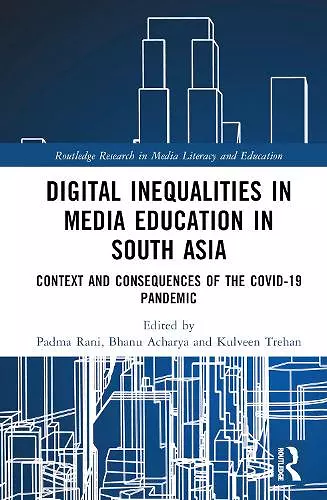Digital Inequalities in Media Education in South Asia
Context and Consequences of the Covid-19 Pandemic
Bhanu Bhakta Acharya editor Padma Rani editor Kulveen Trehan editor
Format:Hardback
Publisher:Taylor & Francis Ltd
Published:24th Jan '25
Currently unavailable, and unfortunately no date known when it will be back

This study explores the media education systems in South Asia, looking not just at the heavy disruption of the Covid-19 pandemic but also the long-standing digital inequalities and unequal socioeconomic opportunities that lead to reduced access to devices, technology, and digital media.
With a focus on eight South Asian countries – Afghanistan, Bangladesh, Bhutan, India, Maldives, Nepal, Pakistan, and Sri Lanka – the chapters examine the adoption of technology for pedagogical purposes during the pandemic, and the underlying socioeconomic reasons behind difficulties in implementing such rapid digital transformation in the region. The authors then consider how we can draw from the performance of South Asian media education institutions, already suffering from various digital divides, during the Covid-19 pandemic, to apply these lessons to the broader academic community.
With contributions from an international team of authors, this book will interest students, scholars, and policymakers around the world working in the areas of media literacy, education studies, digital media, global development, and sociology.
This book, expertly compiled and edited by Professors Padma Rani, Bhanu Bhakta Acharya, and Kulveen Trehan, makes a crucial contribution to the debate about what exactly happens within and across different places, contexts and cultures when the digital environment becomes both a precarious as well a prerequisite factor for participation in society.
Mark Deuze, Professor, Department of Media Studies, University of Amsterdam, The Netherlands
Timely and targeted, this collection of scholarly studies provides powerful arguments for enhancing media education and its growing relevance during medical emergencies such as the Covid-19 pandemic in South Asia, a region where it is sadly lacking and most needed.
Daya Thussu, Professor, Hong Kong Baptist University, President IAMCR
This timely volume explores, with a critical lens, both the challenges faced and the responses mounted in the field of media education, in what is arguably the most diverse and variegated academic landscape in the world—South Asia. The chapters reflect the gamut of experiences in different education settings, and together provide a great starting point for scholars and students of media and communication education in the region as they attempt to make sense of teaching and learning in a post-pandemic world where these inequities persist.
Usha Raman, Professor, Department of Communication, University of Hyderabad, India
Through empirical analysis and critical assessment, the book ‘Digital Inequalities in Media Education in South Asia: Context and Consequences of the Covid-19 Pandemic’ delves into the challenges faced by media education in the region amidst pre-existing digital disparities. It offers valuable insights into how institutions coped with the abrupt shift to virtual platforms, providing a compelling narrative for educators, policymakers, and stakeholders striving for a more inclusive and equitable learning environment.
Massimo Ragnedda, Associate Professor, Media and Communication at Sharjah University (U.A.E.) and Northumbria University (U.K.), Honorary Professor, Moscow State University
This book is a valuable disruption of the digital illusion that shows how the political economy of the digital divides during the Covid-19 pandemic affected media instructors and students in South Asian countries.
Mohammad Sahid Ullah, Professor, Department of Communication and Journalism, University of Chittagong, Bangladesh
The forced movement of teaching and learning online during the Covid-19 pandemic marked a watershed moment for university education, reinforcing embedded institutional and individual inequalities in access to digital technologies and challenging traditional pedagogic practices. This timely volume collects research and testimony from eight South Asian societies to examine how teachers and students of media responded, identify instances of creative adaptation, and specify the essential conditions for maximising the positive uses of ICTs and blended learning. This essential collection is a must-read for anyone wishing to equalise and extend educational opportunities under contemporary conditions and the ever-present threat of the next pandemic.
Graham Murdock, Professor Emeritus of Culture and Economy, Loughborough University, U.K.
The book comprehensively addresses three important dimensions of media education practice – the South Asian context, the impact of inequalities, and the consequences of the pandemic. I congratulate the editors for bringing together critical analysis, country-specific case studies, as well as stakeholder observations and for strongly featuring academic voices from the Global South who have firsthand witnessed and experienced these dimensions.
Manisha Pathak-Shelat, Chair, Centre for Development Management and Communication (CDMC) MICA, India
This ground-breaking book critically examines the severe disruption of media education in South Asia during the Covid-19 pandemic, highlighting how entrenched digital inequalities hindered effective pedagogical transitions. By analyzing the experiences of students and educators across eight countries, it offers critical insights into the challenges and innovative responses that emerged. Essential reading for educators and policymakers, the book underscores the urgency of addressing digital divides to safeguard educational continuity in future crises.
Dorien Kartikawangi, Head, School of Communication, Atma Jaya Catholic University, Indonesia; Chair, ICA Indonesia Chapter
From systemic reviews to country-specific narratives, Digital Inequalities in Media Education in South Asia captures the multifaceted impact of the pandemic on media education across South Asia. It stands as a testament to the resilience and adaptability of educators and students in the face of digital inequalities.
Glenn Muschert, Professor, Khalifa University of Science and Technology, Abu Dhabi, U.A.E.
This compilation of South Asian perspectives, presented by scholars from the region, provides profound insights into a global phenomenon: the digital divide. The causes and effects of the major pedagogical shift in media education induced by mobility restrictions during the Covid-19 outbreak are analyzed based on empirical study. I found the book to be instrumental, especially for students of media studies and anyone interested in the subject matter.
Kundan Aryal, Associate Professor and Head, Central Department of Journalism & Mass Communication, Tribhuvan University, Nepal
ISBN: 9781032557526
Dimensions: unknown
Weight: 453g
346 pages